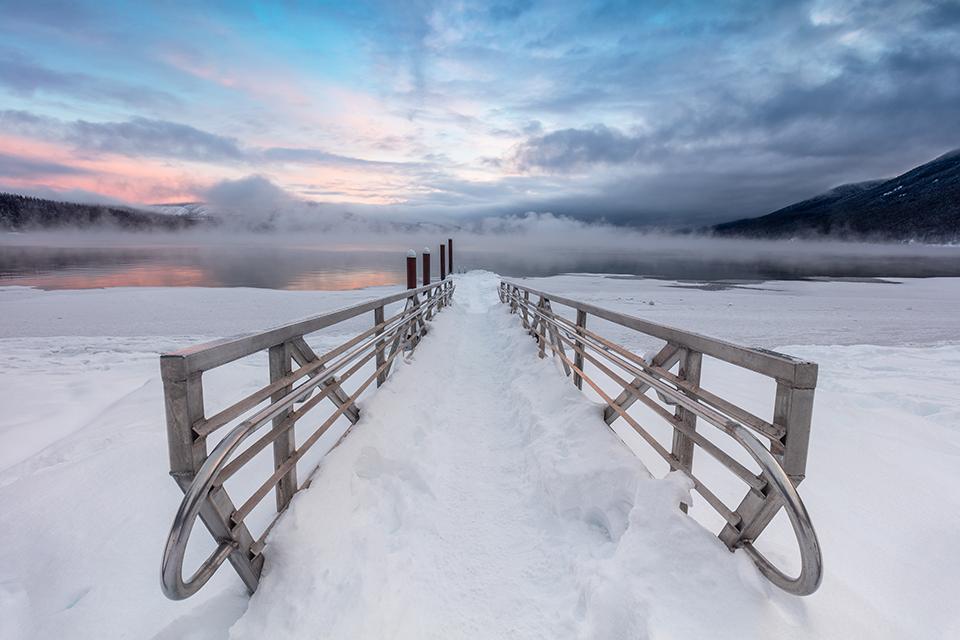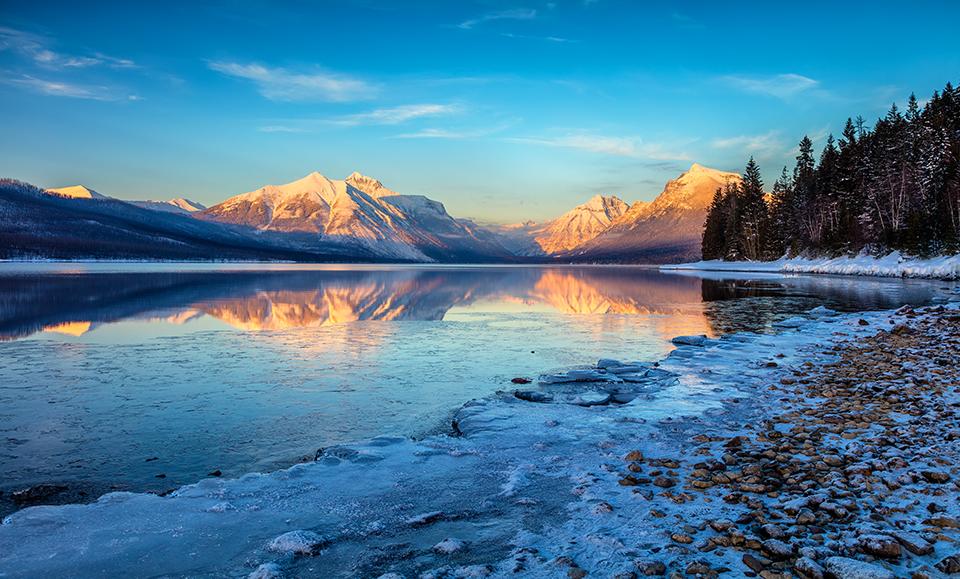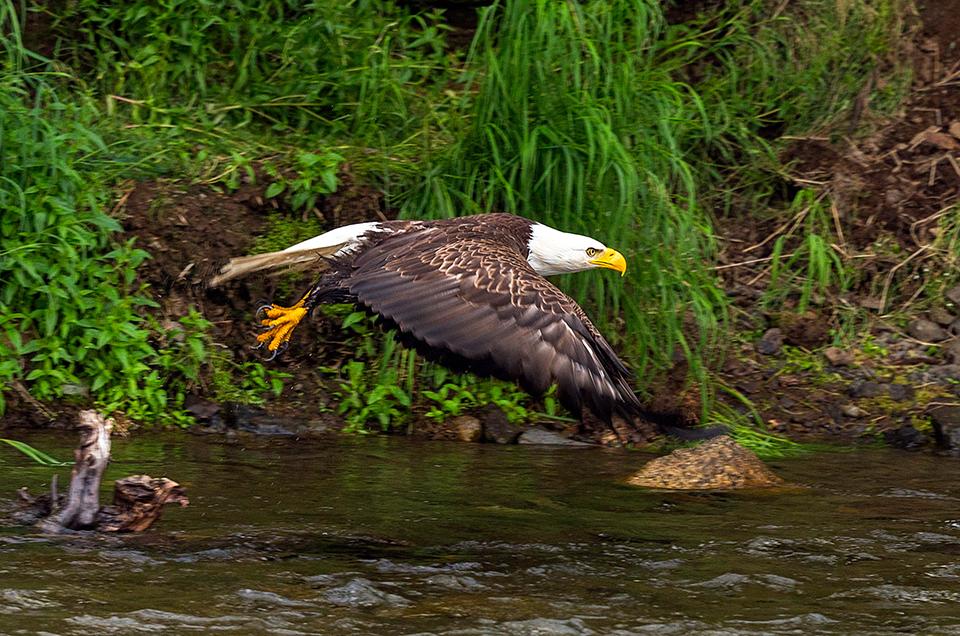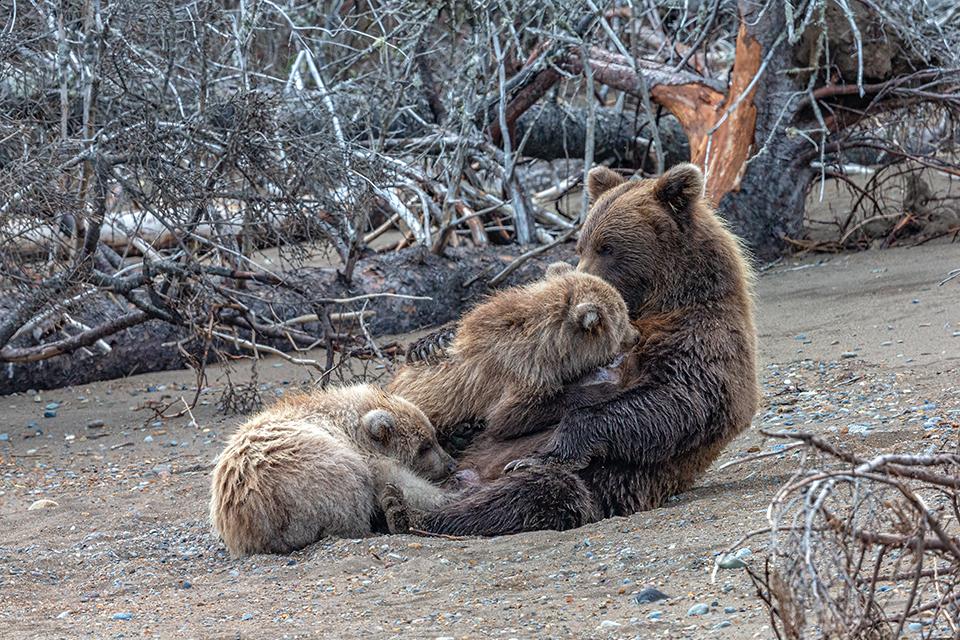
A sub-zero start to morning at Lake McDonald, Glacier National Park / Rebecca Latson
When my sister gets exasperated with me, she’ll say disgustedly “You are sooo impatient!” That’s not really true. My sister and all of her family are far more impatient than I, but it’s always a good arguing point for her whenever we do get into some sort of stupid dispute. Thankfully, that’s not very often, which is surprising considering we are siblings living under the same roof.
I’ve been working on a series of images from past national park visits. These images show a progression over time – sometimes 15 to 30 minutes or longer – and how light and other compositional factors (like clouds or weather) subtly or dramatically change the scene with that passing of time. This, in turn, led me to think about patience (hence that first paragraph) and, in particular, photographic patience. In honing my photography skills over the years, I’ve learned patience (in addition to observation) is a key component to capturing great images. There are instances when it’s wise to stick around the area for a bit longer before deciding to call it quits to wander elsewhere for other shots.
Take this progression of sunrise images (including the one at the top of this article), captured during the space of an hour on a sub-zero morning in Glacier National Park a few years ago.

The beginning of a winter sunrise, Lake McDonald, Glacier National Park / Rebecca Latson

Sunrise's continuance over Lake McDonald, Glacier National Park / Rebecca Latson

Sunrise over Lake McDonald, Glacier National Park / Rebecca Latson

A very cold morning after sunrise at Lake McDonald, Glacier National Park / Rebecca Latson
On a clear day, from the southern shore of Lake McDonald, you can normally see the distant mountains looming over the northern end of the lake. Winter mornings, however, are often not very clear. I had the choice of remaining behind my tripod setup in the snow, keeping my hands toasty with the Hot Hands warmers in each pocket, or, moving along to another spot. I already knew no matter where I drove - which wouldn’t be very far, since the park’s Going-to-the-Sun Road was closed a few miles further at Lake McDonald Lodge - I wouldn’t be seeing the mountains from the shore of Lake McDonald for a period of time, perhaps not until mid-late afternoon. So, I opted to stay put and continue following the progression of light over the snowy landscape. In the photos, you can see both sunlight and clouds moved, with a resulting change in light and color. These changes altered not only the composition but also the mood a viewer of the photos might feel. Such was the reward for my patience.
On a different day in the same park at the same lake, I stood near another photographer, capturing images of the ice-crusted rocky shore and snow-blanketed mountains through the afternoon. As the light changed, so did the landscape. At one point after sunset, the photographer looked over and asked me if I thought there might be anything more, and I told her yes. Sure enough, the setting sun threw up a last hurrah in the form of alpenglow before settling down for the night. The other photographer left, but I remained to capture the blue hour hues of purple, pink, and blue. My patience throughout the day in that spot was rewarded with a progression of wonderful images captured in one of my favorite national parks.

A late winter afternoon at Lake McDonald, Glacier National Park / Rebecca Latson

Sunset at Lake McDonald, Glacier National Park / Rebecca Latson

The end of sunset and beginning of alpenglow over Lake McDonald, Glacier National Park / Rebecca Latson

Alpenglow, Glacier National Park / Rebecca Latson

"Blue Hour" over Lake McDonald, Glacier National Park / Rebecca Latson
Regarding wildlife photography, patience is just as necessary. The longer you watch your subject, the more you’ll learn of its behavior. You might even see some other action going on with some other form of wildlife in the same spot as your original subject. When I visited Katmai National Park and Preserve, I stood cheek-by-jowl with other photographers and their big honkin’ telephoto lenses, all watching the coastal brown bears at Brooks Falls. Shutters would sound off like machine gun fire every time a salmon jumped and a bear reached out, jaws open, in an attempt to grab dinner. While I waited and watched with all the other photographers, I began to focus on other things aside from the bears at the waterfall. Because of this, I captured a cool series of bald eagle images as it took off from a nearby snag in the Brooks River, where it had been doing a little fishing of its own.

Getting ready for takeoff, Katmai National Park and Preserve / Rebecca Latson

Annnnddd, we have liftoff! Katmai National Park and Preserve / Rebecca Latson

Flying away to another spot, Katmai National Park and Preserve / Rebecca Latson
In Lake Clark National Park and Preserve, I stood with other members of the photo tour I attended, watching a mother coastal brown bear with her cubs. After a period of time, after the mother appeared to have accustomed herself to our presence, she let down her guard and nursed her two cubs while we marveled and photographed the experience.

A bear family unit, Lake Clark National Park and Preserve / Rebecca Latson

Ok kids, time for lunch, Lake Clark National Park and Preserve / Rebecca Latson

Got milk? Lake Clark National Park and Preserve / Rebecca Latson
Ok, I know you may be pressed for time when you visit a park, so quick shots of popular spots might be all you want, or are able, to capture. I hear ya. And I’m not trying to convince you to spend an inordinate amount of time in one place if you don’t have that time to spend and there are other places on your list to see. I’m just suggesting if you *do* possess a little time, and are not with someone who is going to pull out their (or your) hair from boredom or impatience, why not stick around for maybe 15-30 extra minutes to see what transpires within a scene.
Here are some tips for the patient photographer:
- As time passes, natural light alters. To capture these alterations within your composition, you should carry two filters in your backpack/gear bag: a circular polarizing filter (CPL) and a graduated neutral density filter (grad ND). While smartphone and point-and-shoot camera users might not have a plethora of choices in filters, there *are* available filters out there. Singh Ray carries a series of filters for your smartphone, and you can search sites like BHphoto and Adorama for available point-and-shoot filters or adapters onto which you can fit filters.
- As time passes, so does the weather. A sunny morning in the mountains may result in rain and snow before brunchtime. Because of this, you should pack along weather protection for your camera (and yourself). There are all sorts of camera weather protection brands out there, like Ruggard, LensCoat RainCoat, Op/Tech, and Vortex Media. Once you and your camera are protected, you can come away with some beautiful before, dramatic during, and awesome after shots of the same landscape when, say, a rainstorm or snowfall passes through.
- You can capture time passing with a time-lapse video. Many point-and-shoot and SLR cameras have a menu setting to for either time-lapse videos or images which you can then combine into a time-lapse video with whatever photo software you use. Smartphones are great at capturing time lapses. All you need (aside from your phone) is a tripod and about 25 or 30+ minutes of patience. That’s right, you can attach your smartphone to a tripod with a mount adapter, ranging in price from less than six dollars on up to almost $30 on Amazon. I think I paid somewhere around $10 for my adapter.
An iPhone 8 time-lapse video captured at Bryce Canyon National Park / Rebecca Latson
Since writing this month’s column, I’ve found quite a few online photo articles about patience (guess I’m not as original as I thought). All of them point to the old sayings that patience is a virtue and it has its rewards. So, when you next visit a national park or protected area, be patient out there with your camera and you’ll be rewarded with a series of incredible shots.




 Support Essential Coverage of Essential Places
Support Essential Coverage of Essential Places







Comments
I found that if you have a favorite park, visit at morning and evening, the light makes the difference.
Exactly, Ann. That's what I tell my readers all the time. In addition to visiting in the morning and evening, it's also a great idea to visit during different seasons and in different weather conditions, too.
Nice work Rebecca. Question for you: on the Blue Hour Lake McDonald shot, were you using a grad or any other filter?
thanks
Thanks, Tom. I did not use a grad ND, but still had my CPL on the lens. I had CPLs on each of the lenses I used throughout that day in that spot, and may have rotated the filter a little, but not enough to eliminate the reflections and see down through the water.
Another very helpful article Rebecca - thanks! I find I'm a lot more patient when out shooting alone - if I'm with someone who's not a photographer I'm always wondering if they're getting mad or upset with me for taking so long. Love seeing the photos from Lake McDonald since I've been to that exact same spot - beautiful place!!
Good info. Thanks for sharing.
With film and early digital, I kept my CPL on as much as possible. But when I switched to mirrorless a few years ago I noticed that it produced overly saturated skies, so I don't normally consider it. I see I need to rethink this...
Appreciate you sharing your photos and answering questions.
Tom